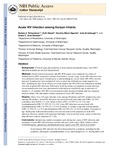| dc.description.abstract | BACKGROUND:
Clinical signs and symptoms of acute human immunodeficiency virus (HIV) infection in infants are not well characterized.
METHODS:
Serial clinical assessments and HIV PCR assays were conducted in a cohort of children born to HIV-seropositive mothers from birth to 2 years of age. Acute HIV infection visits were defined as those up to 3 months prior to and including the visit at which HIV DNA was first detected. Noninfection visits included all visits at which the child had test results negative for HIV, including the last visit at which a test result negative for HIV DNA was obtained in children who later acquired HIV infection. Differences in the prevalence of symptoms at acute infection versus noninfection visits were determined overall and were stratified by age at infection (<2 months vs. >or=2 months). HIV RNA was measured serially in infected infants and was compared between infants with and infants without symptoms of acute HIV infection.
RESULTS:
There were 125 acute infection visits (among 56 infants) and 3491 noninfection visits (among 306 infants). Acute HIV infection was associated with rash (odds ratio [OR], 1.8; 95% confidence interval [CI], 1.1-2.8), failure to thrive (OR, 1.9; 95% CI, 1.0-3.5), and lymphadenopathy (OR, 2.5; 95% CI, 1.4-4.8). Acute HIV infection was associated with lymphadenopathy (OR, 2.6; 95% CI, 1.3-5.0) in infants <2 months of age and with pneumonia (OR, 3.2; 95% CI, 1.1-9.3) and dehydration (OR, 6.0; 95% CI, 1.9-18.5) in infants >or=2 months of age. Infant peak viral load and mortality were not associated with symptoms of acute HIV infection. However, infants with symptoms had higher viral levels later in the course of infection than did those without symptoms (P=.05).
CONCLUSIONS:
Infants may manifest symptoms early during the course of HIV infection, and symptoms of acute HIV infection may correlate with poor viral control. Rash, failure to thrive, lymphadenopathy, pneumonia, and dehydration may signify acute HIV infection in infants. | en |

